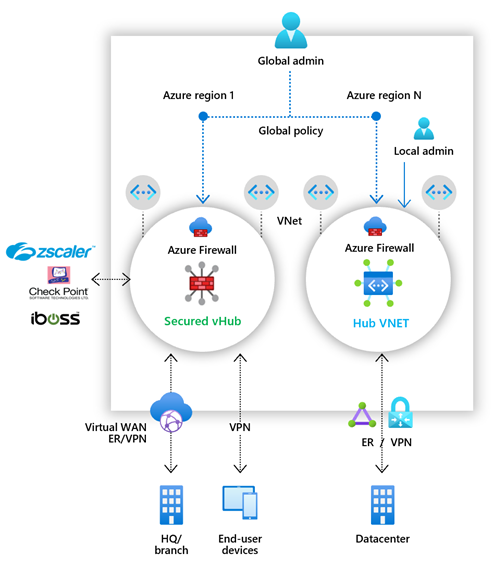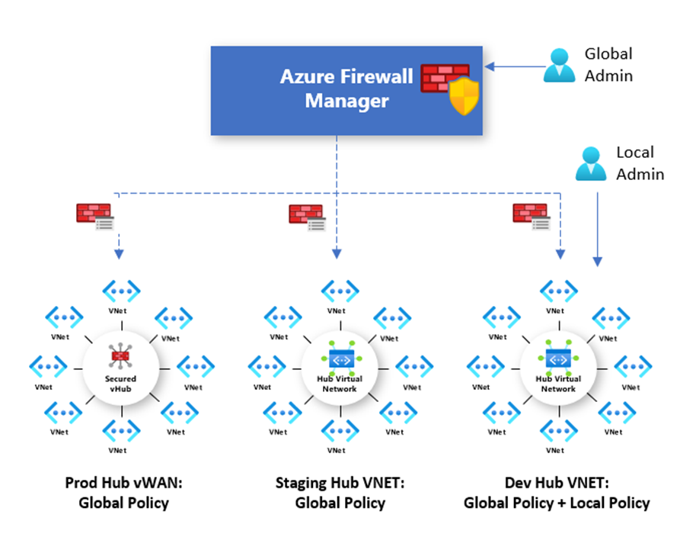Secure your networks with Azure Firewall Manager
Working with Azure Firewall Manager
Azure Firewall Manager is a security management service that provides central security policy and route management for cloud-based security perimeters.

Azure Firewall Manager simplifies the process of centrally defining network and application-level rules for traffic filtering across multiple Azure Firewall instances. You can span different Azure regions and subscriptions in hub and spoke architectures for traffic governance and protection.
If you manage multiple firewalls, it's often difficult to keep the firewall rules in sync. Central IT teams need a way to define base firewall policies and enforce them across multiple business units. At the same time, DevOps teams want to create their own local derived firewall policies that are implemented across organizations. Azure Firewall Manager can help solve these problems.
Firewall Manager can provide security management for two network architecture types:
- Secured Virtual Hub. This name is given to any Azure Virtual WAN Hub with associated security and routing policies. An Azure Virtual WAN Hub is a Microsoft-managed resource that lets you easily create hub and spoke architectures.
- Hub Virtual Network. This name given to any standard Azure virtual network with associated security policies. A standard Azure virtual network is a resource that you create and manage yourself. You can peer spoke virtual networks that contain your workload servers and services. You can also manage firewalls in standalone virtual networks that aren't peered to any spoke.
Azure Firewall Manager features
The key features offered by Azure Firewall Manager are:
Central Azure Firewall deployment and configuration. You can centrally deploy and configure multiple Azure Firewall instances that span different Azure regions and subscriptions.
Hierarchical policies (global and local). You can use Azure Firewall Manager to centrally manage Azure Firewall policies across multiple secured virtual hubs. Your central IT teams can author global firewall policies to enforce organization wide firewall policy across teams. Locally authored firewall policies allow a DevOps self-service model for better agility.
Integrated with third-party security-as-a-service for advanced security. In addition to Azure Firewall, you can integrate third-party security-as-a-service providers to provide extra network protection for your VNet and branch Internet connections. This feature is available only with secured virtual hub deployments.
Centralized route management. You can easily route traffic to your secured hub for filtering and logging without the need to manually set up User Defined Routes (UDR) on spoke virtual networks. This feature is available only with secured virtual hub deployments.
Region availability. You can use Azure Firewall Policies across regions. For example, you can create a policy in the West US region, and still use it in the East US region.
DDoS protection plan. You can associate your virtual networks with a DDoS protection plan within Azure Firewall Manager.
Manage Web Application Firewall policies. You can centrally create and associate Web Application Firewall (WAF) policies for your application delivery platforms, including Azure Front Door and Azure Application Gateway.
Azure Firewall Manager policies
A Firewall policy is an Azure resource that contains NAT, network, and application rule collections and Threat Intelligence settings. It's a global resource that can be used across multiple Azure Firewall instances in Secured Virtual Hubs and Hub Virtual Networks. New policies can be created from scratch or inherited from existing policies. Inheritance allows DevOps to create local firewall policies on top of organization mandated base policy. Policies work across regions and subscriptions.
You can create Firewall Policy and associations with Azure Firewall Manager. However, you can also create and manage a policy using REST API, templates, Azure PowerShell, and the Azure CLI. Once you create a policy, you can associate it with a firewall in a virtual WAN hub making it a Secured Virtual Hub and/or associate it with a firewall in a standard Azure virtual network making it a Hub Virtual Network.

Deploying Azure Firewall Manager for Hub Virtual Networks
The recommended process to deploy Azure Firewall Manager for Hub Virtual Networks is:
Create a firewall policy. You can either create a new policy, derive a base policy, and customize a local policy, or import rules from an existing Azure Firewall. Ensure you remove NAT rules from policies that should be applied across multiple firewalls.
Create a hub and spoke architecture. Either by creating a Hub Virtual Network using Azure Firewall Manager and peering spoke virtual networks to it. Or create a virtual network and add virtual network connections and peering spoke virtual networks to the peering.
Select security providers and associate firewall policy. Currently, only Azure Firewall is a supported provider. Create a Hub Virtual Network, or convert an existing virtual network to a Hub Virtual Network. It's possible to convert multiple virtual networks.
Configure User Defined Routes to route traffic to the Hub Virtual Network firewall.
Deploying Azure Firewall Manager for Secured Virtual Hubs
The recommended process to deploy Azure Firewall Manager for Secured Virtual Hubs is as follows:
Create your hub and spoke architecture. Either create a Secured Virtual Hub using Azure Firewall Manager and add virtual network connections. Or create a Virtual WAN Hub and add virtual network connections.
Select security providers. Create a Secured Virtual Hub, or convert an existing Virtual WAN Hub to a Secure Virtual Hub.
Create a firewall policy and associate it with your hub. Only applicable if you're using Azure Firewall. Third-party security-as-a-service policies are configured via the partners management experience.
Configure route settings to route traffic to your Secured Virtual Hub. You can easily route traffic to your secured hub for filtering and logging without User Defined Routes (UDR) on spoke Virtual Networks by using the Secured Virtual Hub Route Setting page.
Note
You cannot have more than one hub per virtual WAN per region, however you can add multiple virtual WANs in the region to achieve this. Your hub VNet connections must be in the same region as the hub.